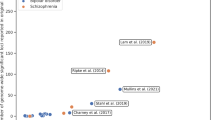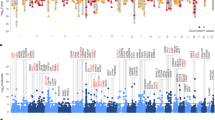Abstract
Genome-wide association studies (GWAS) have identified a number of loci that have strong support for their association with bipolar disorder (BD). The Psychiatric Genome-Wide Association Study (GWAS) Consortium Bipolar Disorder Working Group (PGC-BD) meta-analysis of BD GWAS data sets and replication samples identified evidence (P=6.7 × 10−7, odds ratio (OR)=1.147) of association with the risk of BD at the polymorphism rs9371601 within SYNE1, a gene which encodes nesprin-1. Here we have tested this polymorphism in an independent BD case (n=1527) and control (n=1579) samples, and find evidence for association (P=0.0095) with similar effect sizes to those previously observed in BD (allelic OR=1.148). In a combined (meta) analysis of PGC-BD data (both primary and replication data) and our independent BD samples, we found genome-wide significant evidence for association (P=2.9 × 10−8, OR=1.104). We have also examined the polymorphism in our recurrent unipolar depression cases (n=1159) and control (n=2592) sample, and found that the risk allele was associated with risk for recurrent major depression (P=0.032, OR=1.118). Our findings add to the evidence that association at this locus influences susceptibility to bipolar and unipolar mood disorders.
This is a preview of subscription content, access via your institution
Access options
Subscribe to this journal
Receive 12 print issues and online access
$259.00 per year
only $21.58 per issue
Buy this article
- Purchase on SpringerLink
- Instant access to full article PDF
Prices may be subject to local taxes which are calculated during checkout
Similar content being viewed by others
References
Craddock N, Jones I . Genetics of bipolar disorder. J Med Genet 1999; 36: 585–594.
Craddock N, Sklar P . Genetics of bipolar disorder: successful start to a long journey. Trends Genet 2009; 25: 99–105.
Sullivan PF, de Geus EJ, Willemsen G, James MR, Smit JH, Zandbelt T et al. Genome-wide association for major depressive disorder: a possible role for the presynaptic protein piccolo. Mol Psychiatry 2009; 14: 359–375.
Cichon S, Craddock N, Daly M, Faraone SV, Gejman PV, Kelsoe J et al. Genomewide association studies: history, rationale, and prospects for psychiatric disorders. Am J Psychiatry 2009; 166: 540–556.
Ferreira MA, O’Donovan MC, Meng YA, Jones IR, Ruderfer DM, Jones L et al. Collaborative genome-wide association analysis supports a role for ANK3 and CACNA1C in bipolar disorder. Nat Genet 2008; 40: 1056–1058.
Cichon S, Mühleisen TW, Degenhardt FA, Mattheisen M, Miró X, Strohmaier J et al. Genome-wide association study identifies genetic variation in neurocan as a susceptibility factor for bipolar disorder. Am J Hum Genet 2011; 88: 372–381.
Psychiatric GWAS Consortium Bipolar Disorder Working Group, Sklar P, Ripke S, Scott LJ, Andreassen OA, Cichon S et al. Large-scale genome-wide association analysis of bipolar disorder identifies a new susceptibility locus near ODZ4. Nat Genet 2011; 43: 977–983.
Craddock N, Owen MJ . The Kraepelinian dichotomy—going, going but still not gone. Br J Psychiatry 2010; 196: 92–95.
Moskvina V, Craddock N, Holmans P, Nikolov I, Pahwa JS, Green E et al. Gene-wide analyses of genome-wide association data sets: evidence for multiple common risk alleles for schizophrenia and bipolar disorder and for overlap in genetic risk. Mol Psychiatry 2009; 14: 252–260.
Choi KH, Higgs BW, Wendland JR, Song J, McMahon FJ, Webster MJ . Gene expression and genetic variation data implicate PCLO in bipolar disorder. Biol Psychiatry 2011; 69: 353–359.
Green EK, Grozeva D, Jones I, Jones L, Kirov G, Caesar S et al. The bipolar disorder risk allele at CACNA1C also confers risk of recurrent major depression and of schizophrenia. Mol Psychiatry 2010; 15: 1016–1022.
Liu Y, Blackwood DH, Caesar S, de Geus EJ, Farmer A, Ferreira MA et al. Meta-analysis of genome-wide association data of bipolar disorder and major depressive disorder. Mol Psychiatry 2011; 16: 2–4.
McMahon FJ, Akula N, Schulze TG, Muglia P, Tozzi F, Detera-Wadleigh SD et al. Meta-analysis of genome-wide association data identifies a risk locus for major mood disorders on 3p21.1. Nat Genet 2010; 42: 128–131.
O’Donovan MC, Craddock N, Norton N, Williams H, Peirce T, Moskvina V et al. Identification of loci associated with schizophrenia by genome-wide association and follow-up. Nat Genet 2008; 40: 1053–1055.
Williams HJ, Craddock N, Russo G, Hamshere ML, Moskvina V, Dwyer S et al. Most genome-wide significant susceptibility loci for schizophrenia and bipolar disorder reported to date cross-traditional diagnostic boundaries. Hum Mol Genet 2011; 20: 387–391.
Wing JK, Babor T, Brugha T, Burke J, Cooper JE, Giel R et al. SCAN. Schedules for Clinical Assessment in Neuropsychiatry. Arch Gen Psychiatry 1990; 47: 589–593.
McGuffin P, Farmer A, Harvey I . A polydiagnostic application of operational criteria in studies of psychotic illness. Development and reliability of the OPCRIT system. Arch Gen Psychiatry 1991; 48: 764–770.
Craddock M, Asherson P, Owen MJ, Williams J, McGuffin P, Farmer AE . Concurrent validity of the OPCRIT diagnostic system. Comparison of OPCRIT diagnoses with consensus best-estimate lifetime diagnoses. Br J Psychiatry 1996; 169: 58–63.
Spitzer RL, Endicott J, Robins E . Research diagnostic criteria: rationale and reliability. Arch Gen Psychiatry 1978; 35: 773–782.
American Psychiatric Association. Diagnostic and Statistical Manual of Mental Disorders, 4th edn American Psychiatric Press: Washington, DC, 1994.
Wellcome Trust Case Control Consortium. Genome-wide association study of 14 000 cases of seven common diseases and 3000 shared controls. Nature 2007; 447: 661–678.
Purcell S, Neale B, Todd-Brown K, Thomas L, Ferreira MA, Bender D et al. PLINK: a tool set for whole-genome association and population-based linkage analyses. Am J Hum Genet 2007; 81: 559–575.
Craddock N, Jones L, Jones IR, Kirov G, Green EK, Grozeva D et al. Strong genetic evidence for a selective influence of GABAA receptors on a component of the bipolar disorder phenotype. Mol Psychiatry 2010; 15: 146–153.
Craddock N, Jones I, Kirov G, Jones L . The Bipolar Affective Disorder Dimension Scale (BADDS)—a dimensional scale for rating lifetime psychopathology in bipolar spectrum disorders. BMC Psychiatry 2004; 4: 19–28.
Warren DT, Zhang Q, Weissberg PL, Shanahan CM . Nesprins: intracellular scaffolds that maintain cell architecture and coordinate cell function? Expert Rev Mol Med 2005; 7: 1–15.
Gros-Louis F, Dupre N, Dion P, Fox MA, Laurent S, Verreault S et al. Mutations in SYNE1 lead to a newly discovered form of autosomal recessive cerebellar ataxia. Nat Genet 2007; 39: 80–85.
Zhang Q, Bethmann C, Worth NF, Davies JD, Wasner C, Feuer A et al. Nesprin-1 and -2 are involved in the pathogenesis of Emery Dreifuss muscular dystrophy and are critical for nuclear envelope integrity. Hum Mol Genet 2007; 16: 2816–2833.
Attali R, Warwar N, Israel A, Gurt I, McNally E, Puckelwartz M et al. Mutation of SYNE-1, encoding an essential component of the nuclear lamina, is responsible for autosomal recessive arthrogryposis. Hum Mol Genet 2009; 18: 3462–3469.
International Schizophrenia Consortium, Purcell SM, Wray NR, Stone JL, Visscher PM, O’Donovan MC et al. Common polygenic variation contributes to risk of schizophrenia and bipolar disorder. Nature 2009; 460: 748–752.
The Schizophrenia Psychiatric Genome-Wide Association Study (GWAS) Consortium, Ripke S, Sanders AR, Kendler KS, Levinson DF et al. Genome-wide association study identifies five new schizophrenia loci. Nat Genet 2011; 43: 969–976.
Moskvina V, Holmans P, Schmidt KM, Craddock N . 2005 Design of case-controls studies with unscreened controls. Ann Hum Genet 2011; 69: 566–576.
Tsuang M, Faraone S . The Genetics of Mood Disorders. Johns Hopkins University Press: Baltimore, MD, 1990.
Smoller JW, Finn CT . Family, twin, and adoption studies of bipolar disorder. Am J Med Genet C Semin Med Genet 2003; 123C: 48–58.
Acknowledgements
We are indebted to all individuals who have participated in, or helped with, our research. We particularly thank those involved with MDF—the Bipolar Organization and the Bipolar Disorder Research Network (BDRN). Funding for the sample collection was provided by grants from the Wellcome Trust, Medical Research Council and the Stanley Medical Research Institute. Funding for the genotyping was provided by grants from the Wellcome Trust. We would like to thank the British 1958 Birth Cohort DNA (1958BC) and UK Blood Services collection of Common Controls (UKBC-CC collection) and funders for the control samples used in this study.
Author information
Authors and Affiliations
Corresponding author
Ethics declarations
Competing interests
The authors declare no conflict of interest.
Rights and permissions
About this article
Cite this article
Green, E., Grozeva, D., Forty, L. et al. Association at SYNE1 in both bipolar disorder and recurrent major depression. Mol Psychiatry 18, 614–617 (2013). https://doi.org/10.1038/mp.2012.48
Received:
Revised:
Accepted:
Published:
Issue date:
DOI: https://doi.org/10.1038/mp.2012.48
Keywords
This article is cited by
-
Genetic and functional analyses implicate microRNA 499A in bipolar disorder development
Translational Psychiatry (2022)
-
Semi-parametric empirical Bayes factor for genome-wide association studies
European Journal of Human Genetics (2021)
-
Genetic variants in the bipolar disorder risk locus SYNE1 that affect CPG2 expression and protein function
Molecular Psychiatry (2021)
-
Olfactory Neuroepithelium Cells from Cannabis Users Display Alterations to the Cytoskeleton and to Markers of Adhesion, Proliferation and Apoptosis
Molecular Neurobiology (2021)
-
An integrative analysis of genome-wide association study and regulatory SNP annotation datasets identified candidate genes for bipolar disorder
International Journal of Bipolar Disorders (2020)



